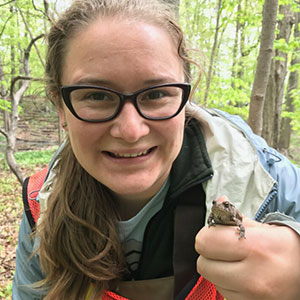Case Western Reserve researchers study competition between frog, toad species in warming climate; gain insight into complexities in accurately predicting outcomes
Scientists contend that both natural history and scientific observation show there will be clear “winners and losers” among species from climate change caused by humans.
But researchers at Case Western Reserve University assert that picking those winners can be a confounding work in progress—a developing science of trying to figure out which assumptions matter for which systems and for which animals.

The research, led by Hilary Rollins, a postdoctoral researcher in biological sciences, and Mike Benard, associate professor in the Case Western Reserve Department of Biology, was published this month in the journal Oecologia. Their findings were drawn from experiments at the 400-acre University Farm in suburban Hunting Valley.
Rollins and Benard demonstrate that among individuals of two similar species—wood frogs (Rana sylvatica) and American toads (Anaxyrus americanus)—even advantages such as larger body size or gaining first access to food and shelter by emerging earlier in the spring—did not necessarily translate into competitive success in a changing climate.
In fact, the toad surprised the researchers by actually growing more when competing against frogs that even had earlier access to food and shelter.
“Part of what we want to convey is that we have these nice predictions from previous literature, but then when you look at how it plays out in real systems, it’s not as straightforward as we thought,” Rollins said. “That’s important because it means that we need to do more testing to really understand the effects of climate change on species.”
Frog, toad and human
So this amphibian battle for superiority and perhaps survival is not only of interest for the frog and toad, but humans as well.
Benard and his team study how changing environments affect the abundance of certain animal populations, their traits and ecological interactions—both in response to variations that occur naturally as well those caused by humans, such as habitat destruction and climate change.
The purpose: Understanding how species respond will help develop strategies to preserve endangered species and control harmful ones.

Benard’s lab mostly works with amphibians, which remain in decline worldwide. His published research in 2018 suggested that excessive, human-caused artificial light at night may be contributing to a worldwide amphibian population decline.
A wealth of previous research has shown that climate change is creating warmer, earlier springs, which are causing the phenology (the timing of their emergence each spring) of many organisms to shift. And as those temperatures increase, body size is reportedly decreasing for frogs, toads and many other ectotherms (animals that derive body heat from the environment).
“It’s important to remember how losing some of these amphibians can affect people,” Benard said. “For one, they sit at the midpoint of our food web: The 10,000 baby frogs that emerge from a single pond can eat a lot of insects, and those that survive to the juvenile or adult stage end up in the stomachs of a lot of wetland birds or raccoons as their food source.”
Rollins said gaining a better understanding of the effects of any loss of biodiversity—whether directly affecting humans or not—is valuable.
“There is a lot to learn and enjoy from these ecosystems, and even a subtle change can impact human health and life,” she said.
The farm experiments

Wood frogs and American toads are ideal for investigating this competition for dominance and survival because they live in the same areas, both metamorphose (go from tadpole to adult amphibian) between May and July, eat similar prey and occupy the same type of shelter among fallen leaves.
Previous research has shown that wood frogs are now breeding earlier, while the toad breeding date hasn’t changed. That has allowed wood frogs to arrive on the scene earlier than toads, but there has been little research to help understand how this may be affecting both species.

The Case Western Reserve researchers manipulated larval food and temperature to artificially raise wood frogs to metamorphose at different times and sizes. The newly metamorphosed toads (unmanipulated) and wood frogs (artificially accelerated) were then placed together and observed for about three months.
The researchers hypothesized that the “early arriving organisms” (the wood frogs) would gain a competitive advantage; that larger organisms of either species would be competitively superior and that there would be an increasingly strong competition among similar-sized organisms.
Those hypotheses played out somewhat different than expected: Not only did the toad grow more when challenged by the early-arriving frogs, but those “wood frogs that were small at the start of the experiment also did not compete as strongly with toads,” Rollins said. While subtle, these results indicate that toads would experience fewer negative effects of competition with wood frogs that metamorphose earlier and smaller under climate change—although the researchers suggest much more research is needed to understand not only the frog-toad interaction, but that of many other species.
For more information, contact Mike Scott at mike.scott@case.edu

